On Finding Out that You Exist...
by Dr Dan Waniek, MD
Copyright © 2006 danwaniek.org
More than sixty years ago George Orwell wrote in The Freedom of the Press, a Preface to his political novel, Animal Farm:
“But at least let us have no more nonsense about defending liberty against Fascism. If liberty means anything at all it means the right to tell people what they do not want to hear...”
This Preface was censored when the book came out in 1945 and it was only published in The Times Literary Supplement on 15 September 1972. That's twenty-seven years after Animal Farm was first published.
There are only twenty-one years since the Model below was nevertheless published (censored as it were by the British Journal of Ophthalmology... ).
Understanding the Iris :
Non-visual functions of the Eye.
Trans-Iridial Studies Updates :
An Electronic Magazine
ISSN 1297-9953
Tuesday, July 25, 2006
Friday, July 21, 2006
Endgames
by Dr Dan Waniek, MD
Copyright © 2006 danwaniek.org
Someone once asked Mahatma Gandhi :
– What do you think about the Western Civilization ?
Gandhi said :
– I think that would be a very good idea !
Copyright © 2006 danwaniek.org
Someone once asked Mahatma Gandhi :
– What do you think about the Western Civilization ?
Gandhi said :
– I think that would be a very good idea !
Tuesday, June 06, 2006
Opus Princeps of Trans-Iridial Studies : Perspective
by Dr Dan Waniek, MD
Copyright © 2006 danwaniek.org
If this explanation proves to be a good working hypothesis, much support may be expected from clinical diagnosis and, possibly, new and noninvasive therapies could be developed.
We have already published results that demonstrate a statistically significant difference between the densitometric pattern of the iris photography between heart disease patients and healthy controls. Screenings can be performed in large populations if they prove to be of high predictive value.
Selective stimulation of zonal transparencies of the iris by an artificial light source, coherent or not, can be a refined and novel therapeutic means. Indeed, simple devices called the SectoStim™ and APIOIDA™ ( Anterior Pole and Iris Optimal Imaging by Directivity Actuation ) are meant to direct the light stimulus in a controlled manner.
For a general discussion of the matter we refer to our monograph on what was operationally defined “ Functio Ocularis Systemica ( FOS ) ”.
Copyright © 2006 danwaniek.org
If this explanation proves to be a good working hypothesis, much support may be expected from clinical diagnosis and, possibly, new and noninvasive therapies could be developed.
We have already published results that demonstrate a statistically significant difference between the densitometric pattern of the iris photography between heart disease patients and healthy controls. Screenings can be performed in large populations if they prove to be of high predictive value.
Selective stimulation of zonal transparencies of the iris by an artificial light source, coherent or not, can be a refined and novel therapeutic means. Indeed, simple devices called the SectoStim™ and APIOIDA™ ( Anterior Pole and Iris Optimal Imaging by Directivity Actuation ) are meant to direct the light stimulus in a controlled manner.
For a general discussion of the matter we refer to our monograph on what was operationally defined “ Functio Ocularis Systemica ( FOS ) ”.
Opus Princeps of Trans-Iridial Studies : Discussion
by Dr Dan Waniek, MD
Copyright © 2006 danwaniek.org
Why should such a peculiar homeostatic mechanism exist ?
Nature develops specific structures to solve specific local problems e. g. different eye systems in fish, insects and mammals. The more diversified these structures are, the more adaptive utilities arise for the same structure.
A “ trivial ” example is the brain, originally limited to some relations between the individual representative of a simple species and its habitat, evolving then to support self-consciousness and creative behavior.
So, an already existing living structure may capture, by its intrinsic possibilities, more external information and make it significant for a higher and finer homeostatic mechanism. This is a kind of useful, effective redundancy that evolution provides for the species when they face viability problems. It may happen because of local environmental presure and also because their own increasing complexity.
Copyright © 2006 danwaniek.org
Why should such a peculiar homeostatic mechanism exist ?
Nature develops specific structures to solve specific local problems e. g. different eye systems in fish, insects and mammals. The more diversified these structures are, the more adaptive utilities arise for the same structure.
A “ trivial ” example is the brain, originally limited to some relations between the individual representative of a simple species and its habitat, evolving then to support self-consciousness and creative behavior.
So, an already existing living structure may capture, by its intrinsic possibilities, more external information and make it significant for a higher and finer homeostatic mechanism. This is a kind of useful, effective redundancy that evolution provides for the species when they face viability problems. It may happen because of local environmental presure and also because their own increasing complexity.
Tuesday, April 11, 2006
Opus Princeps of Trans-Iridial Studies : Meaning
by Dr Dan Waniek, MD
Copyright © 2006 danwaniek.org
The meaning of such differential stimulation of the processi dentati, according to an irido-morphologic code, could be to provide optical information to the cortex - with the purpose of producing specific signals of homeostatic value to targets within the body.
Should this model be true, a coherent possibility for a new homeostatic circle arises :
( a ) A deficient structure within the body might induce changes in iridial morphology
or...
( a' ) deficiencies might be expressed in the morphogenesis of the iris of the same phenotype.
( b ) The iris codes the light signal and transmits it to the ora serrata;
( c ) The ora serrata informs the cortex, acting like a peripheral sensitive homunculus,
(c') possibly via the lateral geniculate body and the pulvinar of the thalamus...
( c'' ) because of their strategic position in the diencephalon;
( d ) The cortex produces homeostatic messages ( nerve impulses or chemical mediators )...
( d' ) to compensate for the deficiency...
( d'' ) possibly by converting normal into “ exceptional ” metabolic pathways.
Copyright © 2006 danwaniek.org
The meaning of such differential stimulation of the processi dentati, according to an irido-morphologic code, could be to provide optical information to the cortex - with the purpose of producing specific signals of homeostatic value to targets within the body.
Should this model be true, a coherent possibility for a new homeostatic circle arises :
( a ) A deficient structure within the body might induce changes in iridial morphology
or...
( a' ) deficiencies might be expressed in the morphogenesis of the iris of the same phenotype.
( b ) The iris codes the light signal and transmits it to the ora serrata;
( c ) The ora serrata informs the cortex, acting like a peripheral sensitive homunculus,
(c') possibly via the lateral geniculate body and the pulvinar of the thalamus...
( c'' ) because of their strategic position in the diencephalon;
( d ) The cortex produces homeostatic messages ( nerve impulses or chemical mediators )...
( d' ) to compensate for the deficiency...
( d'' ) possibly by converting normal into “ exceptional ” metabolic pathways.
Opus Princeps of Trans-Iridial Studies : Model
by Dr Dan Waniek, MD
Copyright © 2006 danwaniek.org
This anatomical entity could be a functional unit for non-visual processing of light information. It would provide homeostatic messages to the brain, not in the form of images, by physiological mechanisms that are still to be discovered.
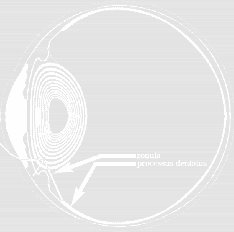
Fig. 5 : Pathways of Light in Sagittal Sections of the Anterior Pole.
The optical information is hypothetically coded by the radial transparency pattern of the iris in terms of intensity, position and specific local absorption of the transmitted light, and is received by the corresponding dentate process.
Copyright © 2006 danwaniek.org
This anatomical entity could be a functional unit for non-visual processing of light information. It would provide homeostatic messages to the brain, not in the form of images, by physiological mechanisms that are still to be discovered.

Fig. 5 : Pathways of Light in Sagittal Sections of the Anterior Pole.
The optical information is hypothetically coded by the radial transparency pattern of the iris in terms of intensity, position and specific local absorption of the transmitted light, and is received by the corresponding dentate process.
Opus Princeps of Trans-Iridial Studies : More Data
by Dr Dan Waniek, MD
Copyright © 2006 danwaniek.org
The observation has been confirmed by many recent photographs taken from the interior of the eyeball, including this original indeed historical one :

Fig : 4 : High resolution intra-ocular photograph taken in vivo, from behind the lens and towards the anterior pole. Courtesy of Paris Match © Lennart Nilssen, 1985, by kind permission.
Copyright © 2006 danwaniek.org
The observation has been confirmed by many recent photographs taken from the interior of the eyeball, including this original indeed historical one :

Fig : 4 : High resolution intra-ocular photograph taken in vivo, from behind the lens and towards the anterior pole. Courtesy of Paris Match © Lennart Nilssen, 1985, by kind permission.
Wednesday, April 05, 2006
Opus Princeps of Trans-Iridial Studies : Data
by Dr Dan Waniek, MD
Copyright © 2006 danwaniek.org
We report here a simple observation to support our functional model : a spatial correspondence between :
(a) radial transparencies in iridial structure,
(b) circular sectors in iridological charts,
(c) inter-processural spaces ( the ciliary valleys ) and
(d) processi dentati,
does indeed exist ( Fig. 3 ).

Fig. 3 : A novel observation concerning the anterior pole's peripherally aligned ( APPA ) vertebrate ocular structures : The spatial correspondence between the radial ( meridional ) structural elements of the iris, the lens and the peripheral retina, as they are viewed from the interior of the eye ( left ) and in medio-sagittal section ( right ) is put into evidence and more diagrammatically shown. There are radial transparencies ( 1 ) and stromal crypts ( 2 ) in the stroma of the iris, and these structures are in a good alignment with the ciliary valleys ( the free space between two adjacent processi ciliares ( 3 ) in pars plicata ). This alignment is shown further in pars plana, where the dentate processi of the retina ( 4 ) protrude along the symmetry axes provided by the striae ( which are not shown ). Light is permitted to reach the processi dentati along this path, considering that total reflection takes place on the anterior surface of the lens and its inter-strata. Only the inferior half of the lens is figured in the left panel. The dots at left stress the repetitive functional unit described here.
Copyright © 1986-2006 danwaniek.org ( Digimarc creator ID 10-727074 ) and the Iris-Ward.com, Inc. Based on an illustration originally published by Churchill Livingstone, with permission. All Rights Reserved.
Copyright © 2006 danwaniek.org
We report here a simple observation to support our functional model : a spatial correspondence between :
(a) radial transparencies in iridial structure,
(b) circular sectors in iridological charts,
(c) inter-processural spaces ( the ciliary valleys ) and
(d) processi dentati,
does indeed exist ( Fig. 3 ).

Fig. 3 : A novel observation concerning the anterior pole's peripherally aligned ( APPA ) vertebrate ocular structures : The spatial correspondence between the radial ( meridional ) structural elements of the iris, the lens and the peripheral retina, as they are viewed from the interior of the eye ( left ) and in medio-sagittal section ( right ) is put into evidence and more diagrammatically shown. There are radial transparencies ( 1 ) and stromal crypts ( 2 ) in the stroma of the iris, and these structures are in a good alignment with the ciliary valleys ( the free space between two adjacent processi ciliares ( 3 ) in pars plicata ). This alignment is shown further in pars plana, where the dentate processi of the retina ( 4 ) protrude along the symmetry axes provided by the striae ( which are not shown ). Light is permitted to reach the processi dentati along this path, considering that total reflection takes place on the anterior surface of the lens and its inter-strata. Only the inferior half of the lens is figured in the left panel. The dots at left stress the repetitive functional unit described here.
Copyright © 1986-2006 danwaniek.org ( Digimarc creator ID 10-727074 ) and the Iris-Ward.com, Inc. Based on an illustration originally published by Churchill Livingstone, with permission. All Rights Reserved.
Opus Princeps of Trans-Iridial Studies : Hypotheses
by Dr Dan Waniek, MD
Copyright © 2006 danwaniek.org
We have hypothesized that the iris may be able to transmit light through its stroma in spite of the irregularly dispersed, heavily absorptive pigment. This transmitted light, without interfering with the centro-retinal image because of total reflection on the anterior surface of the lens is, however, significant, and acts as a coded non-visual stimulus for the periphery of the retina.
The peripheral retina consists of a highly regular array of about seventy protrusions of nervous tissue, the processi dentati, in the pars plana of the ciliary body, collectively named the ora serrata.

This structure has not been understood so far in terms of vision : Indeed, campimetry fails to demonstrate correspondent protrusions in the margins of the visual field, even if there is positive histological evidence of normal receptive retinal structure in the ora serrata, to account for visual perception.
In our model the ora serrata is assumed to have a previously undescribed non-visual function. A critical test of these hypotheses would be to determine whether electro-retinography (ERG) can detect specific activity in the ora serrata when the surface of the iris, and not the pupil is light-stimulated.
This study was undertaken because of controversy existing between the conclusions of different approaches concerning the evaluation of iridology, the controversial diagnostic method based on clinical and empirical studies of the iridial morphology.
Copyright © 2006 danwaniek.org
We have hypothesized that the iris may be able to transmit light through its stroma in spite of the irregularly dispersed, heavily absorptive pigment. This transmitted light, without interfering with the centro-retinal image because of total reflection on the anterior surface of the lens is, however, significant, and acts as a coded non-visual stimulus for the periphery of the retina.
The peripheral retina consists of a highly regular array of about seventy protrusions of nervous tissue, the processi dentati, in the pars plana of the ciliary body, collectively named the ora serrata.

This structure has not been understood so far in terms of vision : Indeed, campimetry fails to demonstrate correspondent protrusions in the margins of the visual field, even if there is positive histological evidence of normal receptive retinal structure in the ora serrata, to account for visual perception.
In our model the ora serrata is assumed to have a previously undescribed non-visual function. A critical test of these hypotheses would be to determine whether electro-retinography (ERG) can detect specific activity in the ora serrata when the surface of the iris, and not the pupil is light-stimulated.
This study was undertaken because of controversy existing between the conclusions of different approaches concerning the evaluation of iridology, the controversial diagnostic method based on clinical and empirical studies of the iridial morphology.
Opus Princeps of Trans-Iridial Studies : Introduction
by Dr Dan Waniek, MD
Copyright © 2006 danwaniek.org
The obvious function of the iris is to provide an optical diaphragm for the system that produces images on the central part of the retina.
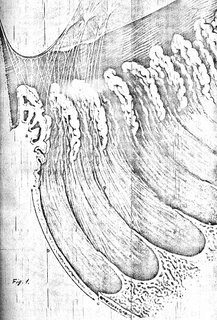
Interestingly, the morphology of the iridial stroma and epithelia seem to support more than the necessities of a highly aperture-adjustable structure. Its crypts and chromatic accidents offer a variable and complicated pattern of densities and transparencies that have stimulated several studies, both scientific and empirical.
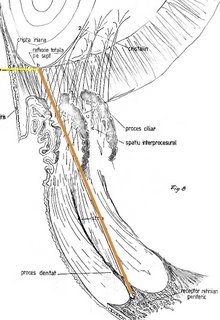
Copyright © 2006 danwaniek.org
The obvious function of the iris is to provide an optical diaphragm for the system that produces images on the central part of the retina.

Interestingly, the morphology of the iridial stroma and epithelia seem to support more than the necessities of a highly aperture-adjustable structure. Its crypts and chromatic accidents offer a variable and complicated pattern of densities and transparencies that have stimulated several studies, both scientific and empirical.

Monday, March 27, 2006
Limits of Trans-Iridial Studies
by Dr Dan Waniek, MD
Copyright © 2006 danwaniek.org
We cannot study a knowledgeable field, empirically as it is defined and limited as we choose it to be, without an external warrant of its logical coherence. Beyond this fundamental limit of any formalized approach - so aptly described by Kurt Goedel - almost any other educated attempt to enhance our understanding will shape both our vision and the detail of its applied exercise.
It so happened that my contemplation once encompassed the iris. Such a delicately colored membrane, so conspicuously present in our own eyes, pushed the limits of my perception just one small but decisive step further, and beyond medical studies. The images of irides were first beheld in the course of my medical endeavor as a countryside family doctor. But their delicate detail, especially the fine structures of these membranes were - certainly - not only beauty in the beholder's eyes.
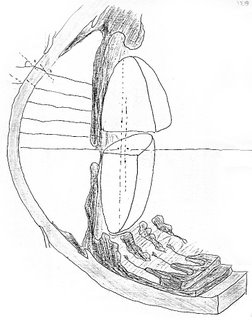
So much truth was in the relationship developed between us that I also grew along these contemplated gems. And I developed my understanding along the lines of similarities between structures of the living and those of the myths and other synthetic forms of ancient knowledge. This idea was operationally named "cardinality" and developed elsewhere. Here I was reaching the point where everything I happened to study was also touched by an idea of beauty.
 Everything looked as if something marvellous was always happening and somebody was somewhere around. In fact, and all along the knowledgeable journey, I was never alone anymore. Not only did I lose an old sentiment of loneliness, but some new and in fact irresistible urge developed in my heart : I tried to describe that beauty. My only caveat henceforth, and eversince, was to proceed systematically. The articles and books in this knowldgeable field were all written as a consequence, practically almost as if by themselves.
Everything looked as if something marvellous was always happening and somebody was somewhere around. In fact, and all along the knowledgeable journey, I was never alone anymore. Not only did I lose an old sentiment of loneliness, but some new and in fact irresistible urge developed in my heart : I tried to describe that beauty. My only caveat henceforth, and eversince, was to proceed systematically. The articles and books in this knowldgeable field were all written as a consequence, practically almost as if by themselves.
Alas, I am aware of the hopeless relativity of my approach and the odd choice of such a delicate enterprise. However, living enough to see it carried through, I can only point to the peace of mind it brought to me, where it mattered most – inside the contemplation process.
Copyright © 2006 danwaniek.org
We cannot study a knowledgeable field, empirically as it is defined and limited as we choose it to be, without an external warrant of its logical coherence. Beyond this fundamental limit of any formalized approach - so aptly described by Kurt Goedel - almost any other educated attempt to enhance our understanding will shape both our vision and the detail of its applied exercise.
It so happened that my contemplation once encompassed the iris. Such a delicately colored membrane, so conspicuously present in our own eyes, pushed the limits of my perception just one small but decisive step further, and beyond medical studies. The images of irides were first beheld in the course of my medical endeavor as a countryside family doctor. But their delicate detail, especially the fine structures of these membranes were - certainly - not only beauty in the beholder's eyes.

So much truth was in the relationship developed between us that I also grew along these contemplated gems. And I developed my understanding along the lines of similarities between structures of the living and those of the myths and other synthetic forms of ancient knowledge. This idea was operationally named "cardinality" and developed elsewhere. Here I was reaching the point where everything I happened to study was also touched by an idea of beauty.
 Everything looked as if something marvellous was always happening and somebody was somewhere around. In fact, and all along the knowledgeable journey, I was never alone anymore. Not only did I lose an old sentiment of loneliness, but some new and in fact irresistible urge developed in my heart : I tried to describe that beauty. My only caveat henceforth, and eversince, was to proceed systematically. The articles and books in this knowldgeable field were all written as a consequence, practically almost as if by themselves.
Everything looked as if something marvellous was always happening and somebody was somewhere around. In fact, and all along the knowledgeable journey, I was never alone anymore. Not only did I lose an old sentiment of loneliness, but some new and in fact irresistible urge developed in my heart : I tried to describe that beauty. My only caveat henceforth, and eversince, was to proceed systematically. The articles and books in this knowldgeable field were all written as a consequence, practically almost as if by themselves.Alas, I am aware of the hopeless relativity of my approach and the odd choice of such a delicate enterprise. However, living enough to see it carried through, I can only point to the peace of mind it brought to me, where it mattered most – inside the contemplation process.
Friday, March 17, 2006
Like Our Own Ancestors, All Mammals Also Have Irides...
by Dr Dan Waniek, MD
Copyright © 2006 danwaniek.org
Take lemurians for instance. Not only their eyes but also their names are significant in a special way. In Mensis Maius, starting at Nonae Maiae , and going through ante diem VIII Idus Maiae, Romans celebrated their origins. It was a special nine-day feast of the dead, Lemuria - their own ancestral cult, brought from somewhere in Thracia Magna, like Dardania and Nicolae Densuşianu's aply pointed Remuria...
Unlike Latin, and even today, Daco-Romanian keeps lamură as a stem word for "origins", "nucleus, the strongest part" or "making pure again" and lămurire for "making as clear as possible".
The story is much deeper and longer. But this gaze, like that in all living iris, tells the beholder a tale of silence and contemplation. For instance, Constantin Noica, one of the greatest philosophers who ever lived - and father of father Rafail - develops these etimological studies in the line of Latin lamina. But who cares about such subtlety in the age of Wikipedia? Talk about involution of species...
 Fig. 2 : Lemurian irides. Lemurians have big eye-to-head ratios and the magic of their gaze is not unlike that special one we happen to feel in humans... It's so simple in fact! The same old story of the remote caste trying to look like the actual caste...
Fig. 2 : Lemurian irides. Lemurians have big eye-to-head ratios and the magic of their gaze is not unlike that special one we happen to feel in humans... It's so simple in fact! The same old story of the remote caste trying to look like the actual caste...
Copyright © 2006 danwaniek.org
Copyright © 2006 danwaniek.org
Take lemurians for instance. Not only their eyes but also their names are significant in a special way. In Mensis Maius, starting at Nonae Maiae , and going through ante diem VIII Idus Maiae, Romans celebrated their origins. It was a special nine-day feast of the dead, Lemuria - their own ancestral cult, brought from somewhere in Thracia Magna, like Dardania and Nicolae Densuşianu's aply pointed Remuria...
Unlike Latin, and even today, Daco-Romanian keeps lamură as a stem word for "origins", "nucleus, the strongest part" or "making pure again" and lămurire for "making as clear as possible".
The story is much deeper and longer. But this gaze, like that in all living iris, tells the beholder a tale of silence and contemplation. For instance, Constantin Noica, one of the greatest philosophers who ever lived - and father of father Rafail - develops these etimological studies in the line of Latin lamina. But who cares about such subtlety in the age of Wikipedia? Talk about involution of species...
 Fig. 2 : Lemurian irides. Lemurians have big eye-to-head ratios and the magic of their gaze is not unlike that special one we happen to feel in humans... It's so simple in fact! The same old story of the remote caste trying to look like the actual caste...
Fig. 2 : Lemurian irides. Lemurians have big eye-to-head ratios and the magic of their gaze is not unlike that special one we happen to feel in humans... It's so simple in fact! The same old story of the remote caste trying to look like the actual caste...
Copyright © 2006 danwaniek.org
Friday, March 10, 2006
How Does an Iris Look Like it Does?
by Dr Dan Waniek, MD
Copyright © 2006 danwaniek.org
It reflects light. Moreover, it produces some light of its own... Last, but not least, it is transparent. All in all, and usually, it looks like this one :
 Fig. 1 : Human Iris. This is the left eye of someone close to me, seen as if you were looking at it yourself, from a small distance. I'm reflected as a Purkinje image myself. No medication. Some mydriasis. Beautiful picture. Serendipitous absence of a real ring flash light must have helped...
Fig. 1 : Human Iris. This is the left eye of someone close to me, seen as if you were looking at it yourself, from a small distance. I'm reflected as a Purkinje image myself. No medication. Some mydriasis. Beautiful picture. Serendipitous absence of a real ring flash light must have helped...
Copyright © 2006 danwaniek.org (Reference 0032-CASE-0090-ACDS).
Copyright © 2006 danwaniek.org
It reflects light. Moreover, it produces some light of its own... Last, but not least, it is transparent. All in all, and usually, it looks like this one :
 Fig. 1 : Human Iris. This is the left eye of someone close to me, seen as if you were looking at it yourself, from a small distance. I'm reflected as a Purkinje image myself. No medication. Some mydriasis. Beautiful picture. Serendipitous absence of a real ring flash light must have helped...
Fig. 1 : Human Iris. This is the left eye of someone close to me, seen as if you were looking at it yourself, from a small distance. I'm reflected as a Purkinje image myself. No medication. Some mydriasis. Beautiful picture. Serendipitous absence of a real ring flash light must have helped...Copyright © 2006 danwaniek.org (Reference 0032-CASE-0090-ACDS).

Friday, March 03, 2006
A Tribute to Hogan, Weddell and Alvarado - Masters of Eye Structures
by Dr Dan Waniek, MD
Copyright © 2006 danwaniek.org
Back in med school years, I never saw anything like this. And I feel I must pay tribute to the work that was most informative during those years, and formative beyond belief.
The authors simply lived inside the eye and flew with the eyeballs in the orbits as if these were not restricting bony sockets. Perhaps seeing is not only believing: seeing the inside of the eye is also living.
Did you know that the iris of the eye is the only living structure we can see in a sea of dead keratin, and stuff - other products of the skin? Look inside Hogan, Weddell and Alvarado's masterpiece and you'll make discoveries that others will never forget. And what is more, you'll see exactly how this thing works so that you might see...
Copyright © 2006 danwaniek.org
Back in med school years, I never saw anything like this. And I feel I must pay tribute to the work that was most informative during those years, and formative beyond belief.
The authors simply lived inside the eye and flew with the eyeballs in the orbits as if these were not restricting bony sockets. Perhaps seeing is not only believing: seeing the inside of the eye is also living.
Did you know that the iris of the eye is the only living structure we can see in a sea of dead keratin, and stuff - other products of the skin? Look inside Hogan, Weddell and Alvarado's masterpiece and you'll make discoveries that others will never forget. And what is more, you'll see exactly how this thing works so that you might see...
About the Author
Copyright © 2009 Dr Dan Armand Waniek, MD
All Rights Reserved. Copyright Requests Here Please !
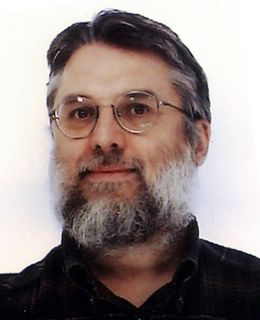
Dan Waniek is a Romanian medical doctor living in Paris, France. He is the author of Abaris the Hyperborean and many Trans-Iridial Studies, nine volumes of which are available for a small fee at iris-ward.com
All Rights Reserved. Copyright Requests Here Please !

Dan Waniek is a Romanian medical doctor living in Paris, France. He is the author of Abaris the Hyperborean and many Trans-Iridial Studies, nine volumes of which are available for a small fee at iris-ward.com

Subscribe to:
Comments (Atom)